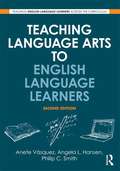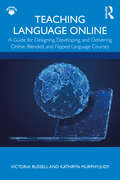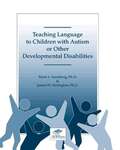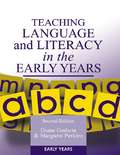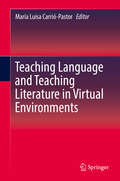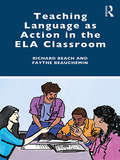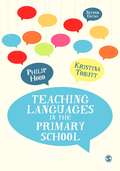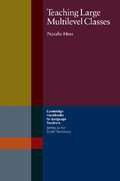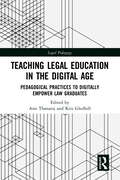- Table View
- List View
Teaching Laboring-Class British Literature of the Eighteenth and Nineteenth Centuries (Options for Teaching #43)
by Kevin Binfield William J. ChristmasBehind our contemporary experience of globalization, precarity, and consumerism lies a history of colonization, increasing literacy, transnational trade in goods and labor, and industrialization. Teaching British laboring-class literature of the eighteenth and nineteenth centuries means exploring ideas of class, status, and labor in relation to the historical developments that inform our lives as workers and members of society. This volume demonstrates pedagogical techniques and provides resources for students and teachers on autobiographies, broadside ballads, Chartism and other political movements, georgics, labor studies, satire, service learning, writing by laboring-class women, and writing by laboring people of African descent.
Teaching Language Arts in Middle Schools: Connecting and Communicating
by Sharon KingenThis text is designed specifically to meet the needs of preservice teachers who have had little experience working in middle-grade classrooms. Three ideas are central: * teaching language arts at the middle level is a complex activity that demands expertise in the use of a variety of strategies, * reading and writing are key processes of language arts study, but so are speaking, listening, and viewing/visually representing, and * teaching the processes of effective communication is crucial, but middle school students must also begin to learn the content of the field--literature, language, and media. Teaching Language Arts in Middle Schools gives balanced attention to various teaching strategies, processes, and content, demonstrating how all of these connect to improve students' abilities to communicate. In this text: *Research and theory are summarized and applied to practice *A non-prescriptive approach is integrated with practical information *Debates in the field are acknowledged *Additional reading and research are emphasized *The author's voice and point of view are explicit
Teaching Language Arts to English Language Learners
by Anete Vásquez Angela L. Hansen Philip C. SmithThis thoroughly revised and updated edition of Teaching Language Arts to English Language Learners provides readers with the comprehensive understanding of both the challenges that face ELLs and ways in which educators might address them in the language arts classroom. The authors offer proven techniques that teachers can readily use to teach reading, writing, grammar, and vocabulary as well as speaking, listening, and viewing skills. A complete section is also devoted to ways teachers can integrate all five strands of the language arts curriculum into a comprehensive unit of study with meaningful accommodations for ELLs. An annotated list of web and print resources completes the volume, making this a valuable reference for language arts teachers to meet the challenges of including all learners in effective instruction. New features to this edition include: An updated and streamlined Part 1, which provides an essential overview of ELL theory in a language arts specific context. Additional practical examples of language arts exercises, all of which are closely aligned with the Common Core State Standards. New pedagogical elements in Part 3, including tips on harnessing new technologies, discussion questions and reflection points. Updates to the web and print resources in Part 4
Teaching Language Arts, Math, and Science to Students With Significant Cognitive Disabilities
by Diane M. Browder Fred SpoonerUnder NCLB, students with severe disabilities are expected to make progress on state academic content standards in language arts, math, and science. But what material should educators teach from these three content areas, and how should they teach it? With this groundbreaking textbook, future educators will have the answers they need. The first major research-to-practice resource on this critical topic, this text goes beyond functional and access skills and shows educators how to make the general curriculum accessible to students of all ages with significant cognitive disabilities. Twenty-five of the best-known researchers in the field prepare educators to - adapt lessons in language arts, math, and science for students with disabilities - identify meaningful instructional content - create effective learning environments through instructional procedures such as peer tutoring, cooperative learning, and co-teaching - set appropriate expectations for student achievement - align instruction with state content standards and alternate assessment For each content area, future teachers will get a solid research foundation blended with teaching examples, guidelines, and helpful figures and tables. A timely textbook for pre-service educators--and a valuable reference for in-service teachers seeking guidance--this important resource will raise expectations for students with disabilities and ensure their progress in key academic areas. Learn how to teach - Language Arts. Move beyond sight-word recognition and teach the literacy components identified by the National Reading Panel - Math. Help students learn higher-level math concepts such as problem solving, reasoning, connections, and representations, as well as functional skills - Science.
Teaching Language Online: A Guide for Designing, Developing, and Delivering Online, Blended, and Flipped Language Courses
by Victoria Russell Kathryn Murphy-JudyPractical and accessible, this book comprehensively covers everything you need to know to design, develop, and deliver successful online, blended, and flipped language courses. Grounded in the principles of instructional design and communicative language teaching, this book serves as a compendium of best practices, research, and strategies for creating learner-centered online language instruction that builds students’ proficiency within meaningful cultural contexts. This book addresses important topics such as finding and optimizing online resources and materials, learner engagement, teacher and student satisfaction and connectedness, professional development, and online language assessment. Teaching Language Online features: A step-by-step guide aligned with the American Council on the Teaching of Foreign Languages (ACTFL), the Common European Framework of Reference (CEFR) for Languages: Learning, Teaching and Assessment, and the World-Class Instructional Design and Assessment (WIDA) standards Research-based best practices and tools to implement effective communicative language teaching (CLT) online Strategies and practices that apply equally to world languages and ESL/EFL contexts Key takeaway summaries, discussion questions, and suggestions for further reading in every chapter Free, downloadable eResources with further readings and more materials available at www.routledge.com/ 9781138387003 As the demand for language courses in online or blended formats grows, K-16 instructors urgently need resources to effectively transition their teaching online. Designed to help world language instructors, professors, and K-12 language educators regardless of their level of experience with online learning, this book walks through the steps to move from the traditional classroom format to effective, successful online teaching environments.
Teaching Language To Chidren With Autism Or Other Developmental Disabilities
by Mark L. Sundberg James W. PartingtonThis is the original must have book for professionals and parents implementing a verbal behavior assessment and intervention program for children with autism or other developmental disabilities (often termed the Verbal Behavior Approach). The book provides an easy to understand introduction to Skinner s analysis of language (i.e., mands, tacts, & intraverbals) with easy to follow examples of everyday language skills demonstrated by children. The book contains a brief language assessment system; the Behavioral Language Assessment Form (BLAF) that will give parents and teachers a quick overview of a child s language skills (see the VB-MAPP for a more thorough assessment). The assessment is followed by descriptions on the basic teaching procedures for developing early and intermediate mands, tacts, echoics, imitation, matching-to-sample, receptive language, and intraverbal skills. The use of sign language and other forms of augmentative communication are presented along with suggestions for IEP goals, skill tracking, and data collection. The book also contains a chapter on the need for both structured discrete trial training (DTT) and natural environment training (NET). This is the latest version of the book and has been re-edited (2010), and professionally typeset thus it is 70 pages less than the original version released in 1998. This version (7.2) is exclusively published by AVB Press.
Teaching Language Variation in the Classroom: Strategies and Models from Teachers and Linguists
by Michelle D. Devereaux Chris C. PalmerBringing together the varied and multifaceted expertise of teachers and linguists in one accessible volume, this book presents practical tools, grounded in cutting-edge research, for teaching about language and language diversity in the ELA classroom. By demonstrating practical ways teachers can implement research-driven linguistic concepts in their own teaching environment, each chapter offers real-world lessons as well as clear methods for instructing students on the diversity of language. Written for pre-service and in-service teachers, this book includes easy-to-use lesson plans, pedagogical strategies and activities, as well as a wealth of resources carefully designed to optimize student comprehension of language variation.
Teaching Language and Communication to the Mentally Handicapped (Routledge Library Editions: Special Educational Needs #35)
by Peter Mittler Will Swann Judith Coupe Ken LeemingFirst published in 1979. This report offers a working model for the teaching of language and communication to the mentally handicapped which derives from both theory and practice, and tries to build a bridge between them. It provides detailed examples of teachers putting principles into action and illustrates how teachers and children work together. The report will be of interest to all those concerned with the welfare of the handicapped child, including the parents. It provides both a working text for teachers, and a basis for critical discussion about curriculum development and content in special needs schools.
Teaching Language and Content in Multicultural and Multilingual Classrooms: CLIL and EMI Approaches
by María Luisa Carrió-Pastor Begoña Bellés-FortuñoThis edited book explores critical issues relating to Content and Language Integrated Learning (CLIL) and English as a Medium of Instruction (EMI), setting out their similarities and differences to demystify the terms and their implications for classroom practice. The authors show how CLIL and EMI practices are carried out in different institutional contexts and demonstrate how both approaches can benefit language and content acquisition. This book is addressed to second/foreign language teaching staff involved in teaching in English at primary education, secondary education, and higher education levels.
Teaching Language and Literacy in the Early Years
by Margaret Perkins Diane GodwinThe early years are increasingly recognized as a priority time for the education of children and language and literacy are key elements of any early childhood program. This second edition provides an accessible text on the current research and thinking surrounding these areas and demonstrates clearly how this theory can work in practice. The authors provide guidance on planning, assessment and recording; suggest appropriate activities, resources and play ideas to help those who work with or are planning to work within the foundation stage. The second edition includes specific reference to both the curriculum guidance for the Foundation Curriculum and the framework of teaching objectives for the National Literacy Strategy and puts these within a framework which acknowledges the centrality of play and talk in the early years. The book is firmly grounded in the requirements of the Foundation curriculum and is a suitable textbook for undergraduate early childhood courses, all those following routes into early years teaching, and existing practitioners in all types of early years settings. The book will also be appropriate reading for LEA advisers and those who inspect early years settings.
Teaching Language and Literature in Elementary Classrooms: A Resource Book for Professional Development
by Marcia S. PoppThe goal of this book -- a theoretically based, well-organized, useful guide for teaching -- is to help the beginning teacher create a classroom environment that integrates literacy development with learning in all areas of the curriculum. The major components of an integrated language program are identified, and the skills teachers need to implement this kind of program in their own classrooms are described. Designed to be kept and used as a resource in the classroom, this text provides fundamental information about language arts teaching. A constructivist orientation, an emphasis on teachers as reflective decision makers, and vivid portrayals of the classroom as a community of learners and inquirers are woven throughout the book. Key features include: * a wealth of models, suggestions, and step-by-step guidelines for introducing integrated teaching and learning practices into elementary classrooms at the kindergarten, primary, and intermediate levels; * a focus on relevant research in language arts and professional teacher development; * true-to-life classroom narratives that model instructional strategies and demonstrate interactions between real teachers and students; and * an innovative chapter format that makes the text accessible as a resource for student, beginning, and experienced teachers.
Teaching Language and Teaching Literature in Virtual Environments
by María Luisa Carrió-PastorThis book sheds new light on language and literature teaching, and offers examples of teaching language in virtual environments. Providing an overview of virtual environments for teaching, it also includes chapters devoted to methodology design for second language teaching in these environments. Further it describes tools for second/ foreign language teaching and proposals for specific second language teaching in virtual environments. Lastly, it presents experiments on literature teaching in virtual environments and discusses the future of technology in education. With interdisciplinary appeal, the book is a particularly valuable resource for scholars with an interest in technology, language teaching and literature teaching.
Teaching Language as Action in the ELA Classroom
by Richard Beach Faythe BeaucheminThis book explores English language arts instruction from the perspective of language as "social actions" that students and teachers enact with and toward one another to create supportive, trusting relations between students and teachers, and among students as peers. Departing from a code-based view of language as a set of systems or structures, the perspective of languaging as social actions takes up language as emotive, embodied, and inseparable from the intellectual life of the classroom. Through extensive classroom examples, the book demonstrates how elementary and secondary ELA teachers can apply a languaging perspective. Beach and Beauchemin employ pedagogical cases and activities to illustrate how to enhance students’ engagement in open-ended discussions, responses to literature, writing for audiences, drama activities, and online interactions. The authors also offer methods for fostering students' self-reflection to improve their sense of agency associated with enhancing relations in face-to-face, rhetorical, and online contexts.
Teaching Languages Creatively (Learning to Teach in the Primary School Series)
by Philip HoodTeaching Languages Creatively brings together the experience of international primary language experts to explore creative teaching and learning in primary languages. Drawing on the latest research and theory and illustrated with ideas and case studies from real schools, it covers key topics, including: engaging students in the target language; celebrating bilingualism in the classroom; incorporating technology into modern teaching; integrating language learning across the curriculum; successful transitions; learning languages through singing, storytelling and dance. Ideal for primary trainee teachers, newly qualified teachers, and established teachers looking for creative new ideas to enrich the learning experience of their students, Teaching Languages Creatively is an essential guide for inspiring the love of languages that is so vital for young learners.
Teaching Languages Online
by Carla Meskill Natasha AnthonyNovice and experienced educators who have considered moving some or all of their language courses online will find this text an invaluable starting point and resource throughout the process. In non-technical prose with emphasis throughout on excellence in pedagogical practice, the text takes both the new and experienced language instructor through the nuts and bolts of online teaching practices and uses multiple examples of online instructional conversations to illustrate these practices. Teaching in asynchronous written, asynchronous aural, synchronous written, synchronous aural and combinations of these environments are discussed and exemplary practices provided for each. An excellent place to both begin and augment language teaching online.
Teaching Languages in the Primary School
by Philip Hood Kristina TobuttLanguages are now a more important part of primary education than ever before, and all successful primary teachers need to understand the principles that support good language teaching and learning. This second edition provides a coherent overview of teaching and learning languages, combining practical strategies for use in the classroom with engaging coverage of how to teach, informed by academic research and theory. Key features of this new edition: Fully updated coverage of policy and curriculum developments, including the 2014 National Curriculum and the Teachers' Standards A new chapter on curriculum, planning and assessment for KS2 Expanded coverage of the transition from primary to secondary school and the implications for teaching More examples of creative teaching and learning throughout. This is essential reading for all students studying primary languages on initial teacher education courses, including undergraduate (BEd, BA with QTS), postgraduate (PGCE, School Direct, SCITT), and also NQTs.
Teaching Languages in the Primary School
by Philip Hood Kristina TobuttLanguages are now a more important part of primary education than ever before, and all successful primary teachers need to understand the principles that support good language teaching and learning. This second edition provides a coherent overview of teaching and learning languages, combining practical strategies for use in the classroom with engaging coverage of how to teach, informed by academic research and theory. Key features of this new edition: Fully updated coverage of policy and curriculum developments, including the 2014 National Curriculum and the Teachers’ Standards A new chapter on curriculum, planning and assessment for KS2 Expanded coverage of the transition from primary to secondary school and the implications for teaching More examples of creative teaching and learning throughout. This is essential reading for all students studying primary languages on initial teacher education courses, including undergraduate (BEd, BA with QTS), postgraduate (PGCE, School Direct, SCITT), and also NQTs.
Teaching Large Classes in Higher Education: How to Maintain Quality with Reduced Resources
by Alan Jenkins Graham GibbsThis guide combines theory on teaching methodology with advice on good teaching practice in order to help teachers face the challenge of larger numbers of students in their classrooms. It includes a number of case studies which explore innovative teaching methods.
Teaching Large Multilevel Classes
by Penny Ur Natalie HessThis book provides practical advice for teachers who work with large, mixed-ability classes. It offers a wide variety of activities to develop student motivation, interest, participation and responsibility.
Teaching Late-Twentieth-Century Mexicana and Chicana Writers (Options for Teaching #53)
by Elizabeth Coonrod MartínezMexicana and Chicana authors from the late 1970s to the turn of the century helped overturn the patriarchal literary culture and mores of their time. This landmark volume acquaints readers with the provocative, at times defiant, yet subtle discourses of this important generation of writers and explains the influences and historical contexts that shaped their work.Until now, little criticism has been published about these important works. Addressing this oversight, Teaching Late-Twentieth-Century Mexicana and Chicana Writers starts with essays on Mexicana and Chicana authors. It then features essays on specific teaching strategies suitable for literature surveys and courses in cultural studies, Latino studies, interdisciplinary and comparative studies, humanities, and general education that aim to explore the intersectionalities represented in these works. Experienced teachers offer guidance on using these works to introduce students to border studies, transnational studies, sexuality studies, disability studies, contemporary Mexican history and Latino history in the United States, the history of social movements, and concepts of race and gender.
Teaching Law
by Robin L. WestTeaching Law reimagines law-school teaching and scholarship by going beyond crises now besetting the legal academy and examining deeper and longer-lasting challenges. The book argues that the legal academy has long neglected the needs to focus teaching and scholarship on the ideals of justice that law fitfully serves, the political origins of law, and the development of a respectful but critical relationship with the legal profession. This book suggests reforms to improve the quality of legal education and responds to concerns that law schools eschew the study of justice, rendering students amoralist; that law schools slight the political sources of law, particularly in legislative action; and that law schools have ignored the profession entirely. These areas of neglect have impoverished legal teaching and scholarship as the academy is refashioned in response to current financial exigencies, and addressing them is long overdue.
Teaching Leadership: An Integrative Approach (Leadership: Research and Practice)
by Barbara C. CrosbyTeaching Leadership provides guidance for leadership educators in a variety of organizational and community contexts and across academic disciplines. An experienced leadership educator, Crosby promotes an inclusive vision of leadership that recognizes the inherent leadership potential in everyone. Featuring interviews with 25 respected leadership educators, Teaching Leadership complicates and enriches the leader-follower dichotomy to advance a holistic and practice-oriented model of leadership education. Using the metaphor of ‘heart, head, and hands,’ Crosby shows how authentic leadership is an embodied practice based equally in emotional, intellectual, and experiential learning.
Teaching Learning and New Technologies in Higher Education
by N. V. Varghese Sayantan MandalThis book discusses emerging issues related to teaching-learning in Indian higher education and the integration of technology. It brings together a host of national and international experts specializing in various aspects of teaching-learning in higher education, technology, and classroom practices to present policy and organizational strategies for enhancing innovation in teaching-learning processes, and offers a comprehensive overview of teaching-learning in connection with broader themes and concerns such as academic freedom, globalization, and new technologies. Reviewing a wide range of current practices and discussing specific teaching-learning challenges in depth, the book will be of interest to researchers and students of education, practitioners of higher education policy, and teacher educators alike.
Teaching Legal Education in the Digital Age: Pedagogical Practices to Digitally Empower Law Graduates (Legal Pedagogy)
by Kris Gledhill Ann ThanarajTeaching Legal Education in the Digital Age explores how legal pedagogy and curriculum design should be modernised to ensure that law students have a realistic view of the future of the legal profession. Using future readiness and digital empowerment as central themes, chapters discuss the use of technology to enhance the design and delivery of the curriculum and argue the need for the curriculum to be developed to prepare students for the use of technology in the workplace. The volume draws together a range of contributions to consider the impact of digital pedagogies in legal education and propose how technology can be used in the law curriculum to enhance student learning in law schools and lead excellence in teaching. Throughout, the authors consider what it means to be future-ready and what we can do as law academics to facilitate the knowledge, skills and dispositions needed by future-ready graduates. Part of Routledge’s series on Legal Pedagogy, this book will be of great interest to academics, post-graduate students, teachers and researchers of evidence law, as well as those with a wider interest in legal pedagogy or legal practice.
Teaching Life Skills in the Liberal Arts and Sciences: Preparing Students for Success Beyond the Classroom
by Angela C. BauerToday’s students seek an education that connects classroom learning to their future success, both personal and professional. Teaching Life Skills in the Liberal Arts and Sciences: Preparing Students for Success Beyond the Classroom is a practical guide for faculty and academic leaders who wish to meet this need by intentionally teaching and assessing the skills that employers most value: critical thinking, teamwork, emotional intelligence, cultural competence, ethical reasoning, and coachability.Grounded in research from higher education and employer surveys, this book provides evidence-based strategies for teaching and assessing key life skills, while still honoring the traditions of the liberal arts. Chapters feature detailed guidance and creative prompts for using AI tools to further enhance instructional design. By connecting academic experiences with students’ long-term goals, this book reaffirms the enduring relevance of a liberal arts education and offers a sustainable path forward in a rapidly changing world.


